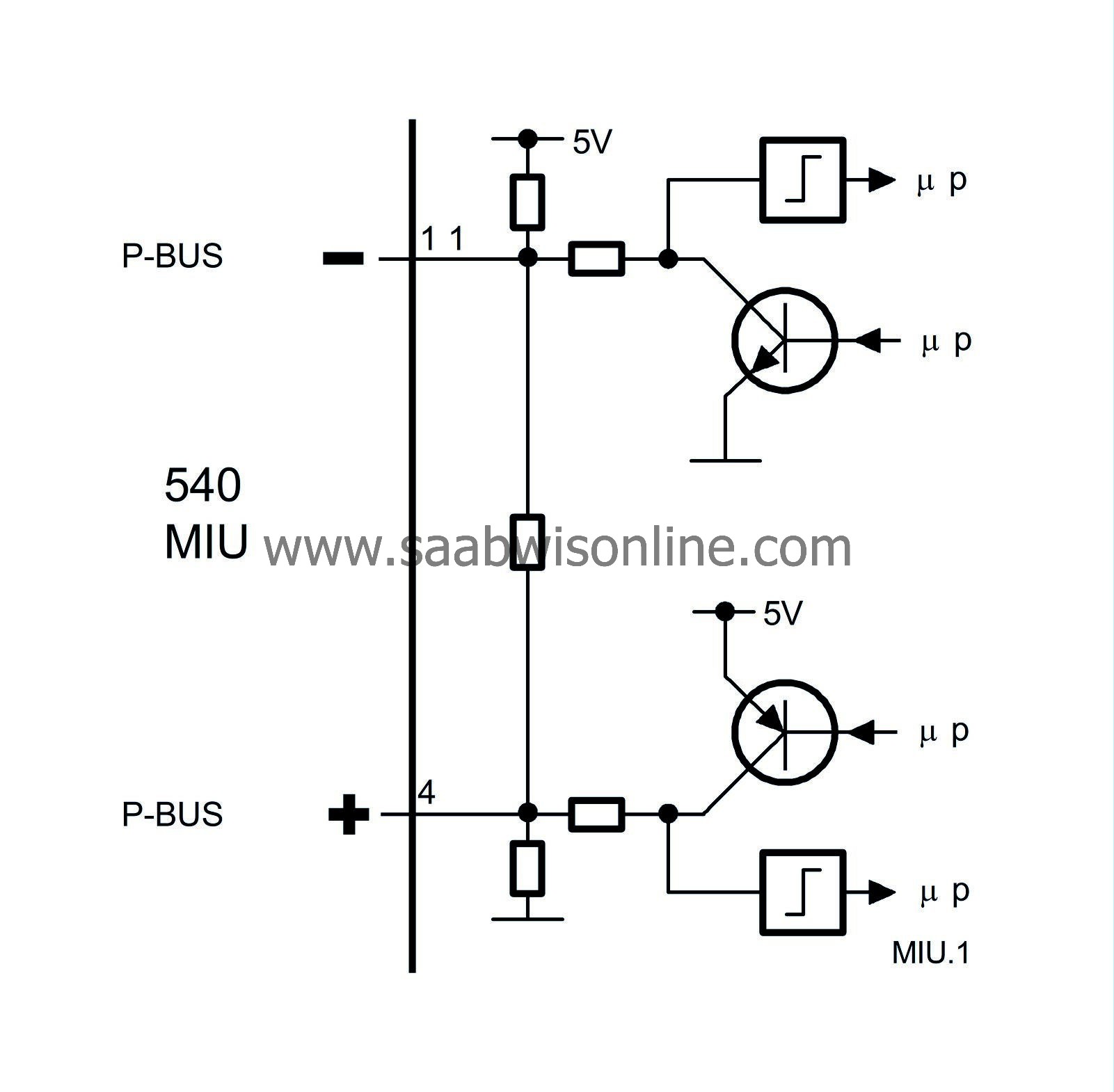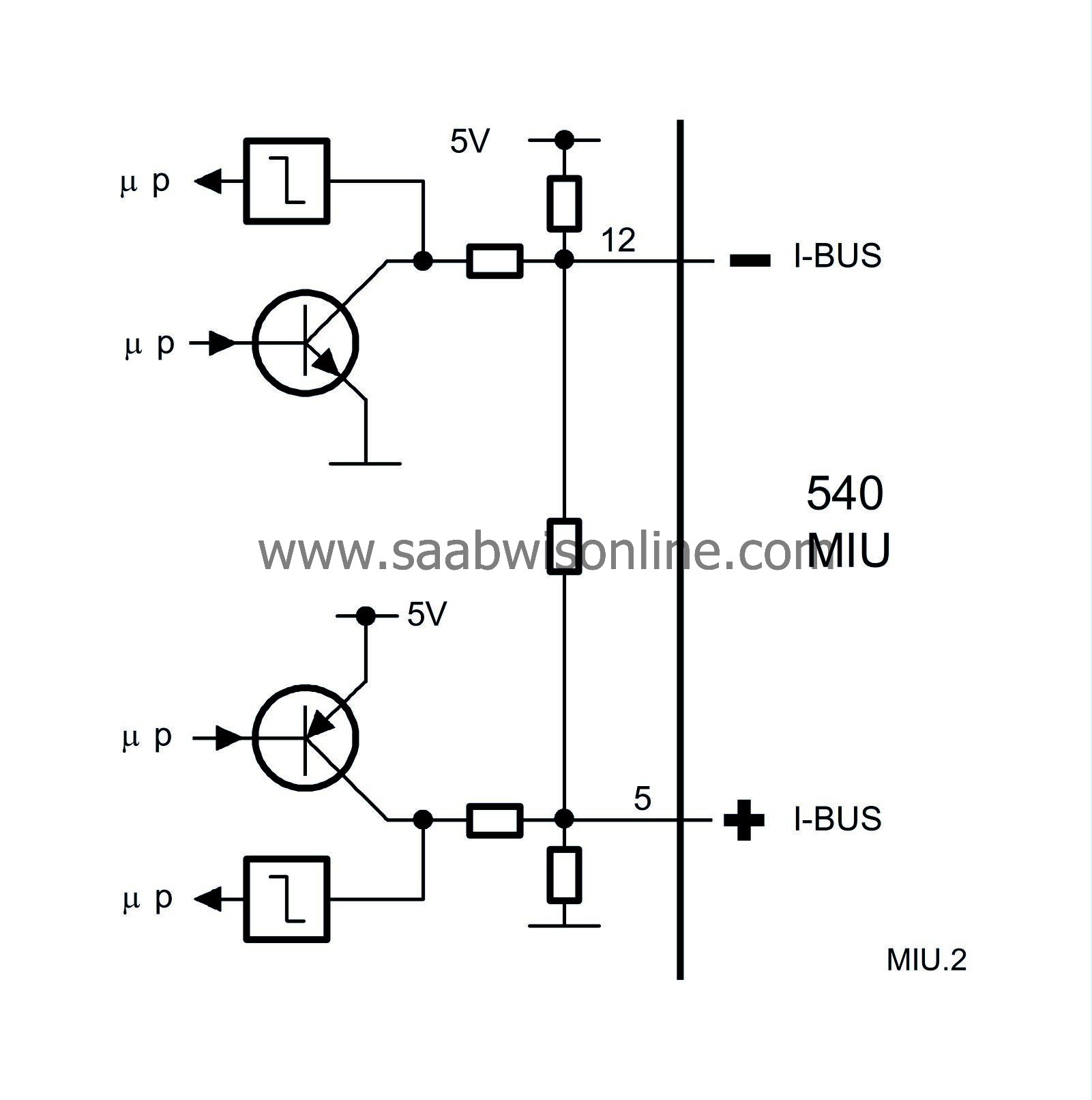Bus communication
| Bus communication |
| • |
Trionic, engine management system (TRIONIC)
|
|
| • |
TCM (Transmission Control Module), control module for automatic transmission (502)
|
|
| • |
TC/ABS (Traction Control) (382)
|
|
| • |
P-bus (Powertrain bus)
|
|
| • |
MIU (Main Instrument Unit) (540)
|
|
| • |
I-bus (Instrument bus)
|
|
| • |
SID (Saab Information Display) (541)
|
|
| • |
TWICE (Theft Warning Integrated Central Electronics) (632)
|
|
| • |
ACC (Automatic Climate Control) (216)
|
|
| • |
Audio system, main unit (353)
|
|
| • |
CDC (CD changer) (355)
|
|
| • |
PSM (Power Seat Memory) (357Dk)
|
|
| • |
PMM (Power Mirror Memory) (611)
|
|
| • |
DICE (Dashboard Integrated Central Electronics) (628)
|
|
| • |
Data link connector (H16-5/445)
|
|
| • |
Airbag (SRS) (331)
|
|
| • |
ABS (Anti-lock Brake System) (547)
|
|
| • |
SPA (Saab Parking Assistance) (630)
|
|


| P-bus and I-bus |
A bus is understood to be the leads over which information is sent digitally and serially. Digital means that the voltage difference between the leads has only two values, roughly 0 V and 5 V. The information is coded so that different combinations of 0 V and 5 V pulses have different meanings.
Serial means that the information is sent in ”packets” which are transmitted one after the other in rapid succession.
All control modules in the Saab 9-5 are connected to the bus with the exception of ABS and SRS. For cars with Traction Control, the TC/ABS control module is connected to the P-bus.
The buses consist of a P-bus (Powertrain Bus) and an I-bus (Instrument Bus). Both buses are connected to the MIU (Main Instrument Unit). The buses are electrically isolated from each other.
The diagnostic tool is not connected direct to the bus but communicates via the DICE, one of the control modules connected to the I-bus, and so has access to all control modules connected to the bus.
Vehicle speed data is important for many control modules. Since ABS is not connected to the bus, the vehicle speed signal is sent on a lead from ABS to MIU. MIU then sends the data over the buses. In cars with Traction Control, the TC/ABS sends vehicle speed data via the P-bus.
The data transfer rate of the P-bus is ten times faster than that of the I-bus. The reason for this is that the powertrain systems need information with the least possible delay, as for example when providing air mass compensation when the selector lever is moved from N to D or torque limitation in connection with gear changing.
All the information sent from one control module is accessible for all other control modules on the bus. The MIU is responsible for ensuring that information available on one bus is also available on the other bus.
The control modules send out information on the bus at regular intervals. The time between two transmissions depends on the information being sent and varies between 10 milliseconds (0.010 seconds) and 1 second. Information is also sent out by the control modules whenever the information changes.
The transfer of information between control modules takes place on two leads, bus+ (green lead) and bus- (white lead). The leads are twisted to reduce susceptibility to electrical interference.
| The MIU uses the following information: |
| Information | Values | From | The value depends on the following sensor input, signal or function |
|
LH direction indicators
|
On/Off
|
DICE
|
Control module activation of the output to the lamps. The MIU turns on the left direction indicator repeater lamp.
|
|
RH direction indicators
|
On/Off
|
DICE
|
Control module activation of the output to the lamps. The MIU turns on the right direction indicator repeater lamp.
|
|
Rear fog light
|
On/Off
|
DICE
|
Control module activation of the output to the lamps. The MIU turns on the rear fog light indicator lamp.
|
|
Driver's door
|
OPEN/CLOSED
|
TWICE
|
Door switch. The MIU lights the driver's door symbol.
|
|
Passenger's door
|
OPEN/CLOSED
|
TWICE
|
Door switch. The MIU lights the passenger door symbol.
|
|
Rear door, LH
|
OPEN/CLOSED
|
TWICE
|
Door switch. The MIU lights the rear left door symbol.
|
|
Rear door, RH
|
OPEN/CLOSED
|
TWICE
|
Door switch. The MIU lights the rear right door symbol.
|
|
Boot lid
|
OPEN/CLOSED
|
TWICE
|
Door switch. The MIU lights the tailgate symbol.
|
|
Steering wheel location
|
LHD/RHD
|
TWICE
|
Control module programming. The MIU lights the driver's/passenger door indicator
|
|
Info Disp Lamp
|
On/Off
|
SID
|
For text messages. The MIU lights the Info Display indicator lamp.
|
|
Rheostat level
|
0-100 %
|
SID
|
Rheostat control module input. Rheostat value.
|
|
Rheostat Night Panel
|
0-100 %
|
SID
|
Rheostat control module input reduced internally by a fixed value.
|
|
Night Panel
|
On/Off
|
SID
|
Button. The MIU extinguishes certain instrument and display lighting.
|
|
Display lighting
|
0-100 %
|
SID
|
Rheostat control module input or light sensor, highest value. The MIU uses the information to control the light intensity of the display.
|
|
Brightness in cabin
|
Lux
|
SID
|
Light sensor. The MIU uses the value to control the intensity of the indicator lamps.
|
|
Check engine lamp
|
On/Off
|
Trionic
|
Internal diagnosis. The MIU lights the CHECK ENGINE lamp.
|
|
Shift Up lamp
|
On/Off
|
Trionic
|
Front right wheel speed (lead from ABS). The MIU lights the Shift Up lamp.
|
|
CRUISE Lamp
|
On/Off
|
Trionic
|
Cruise Control function. The MIU lights the CRUISE lamp.
|
|
Fuel Consumed Since Start
|
0-65535 ml
|
Trionic
|
Fuel injection function. Used by the SID for trip computer functions. Can be adjusted with an offset in the MIU.
|
|
Engine speed
|
0-7000 rpm
|
Trionic
|
Crankshaft position sensor. The MIU controls the tachometer.
|
|
Coolant temperature
|
-40-215°C
|
Trionic
|
Coolant temperature sensor. The MIU controls the coolant temperature gauge.
|
|
Selector lever position
|
P, R, N, D, 3, 2, 1
|
TCM
|
Selector lever position sensor. The MIU lights the relevant indicator lamp.
|
|
CHECK GEARBOX lamp
|
On/Off
|
TCM
|
Internal diagnosis. The MIU lights the CHECK GEARBOX lamp.
|
|
SPORT Lamp
|
On/Off
|
TCM
|
Button and oil temperature sensor, not Limp-Home or WINTER. The MIU lights the SPORT lamp.
|
|
WINTER Lamp
|
On/Off
|
TCM
|
Button and oil temperature sensors, not Limp-Home. The MIU turns on the WINTER lamp.
|
|
RL wheel speed
|
0-300 km/h
|
TC/ABS
|
RL wheel speed sensor.
|
|
ABS lamp
|
On/Off
|
TC/ABS
|
Internal diagnosis.
|
|
TCS OFF lamp
|
On/Off
|
TC/ABS
|
Switch, internal diagnosis.
|
|
TCS lamp
|
On/Off
|
TC/ABS
|
Traction Control modulation
|
|
Diagnostics communication
|
Control module should be live and the bus leads intact. DICE/Diagnostics tool.
|
| The MIU sends the following information: |
| Information | Values | Used by | The value depends on the following sensor input, signal or function |
|
Vehicle speed
|
km/h (mph)
|
Trionic, DICE, SID, ACC, Audio, TWICE
|
Rear left wheel speed (lead from ABS). The main instrument unit calculates the current vehicle speed from the speed information sent by the TC/ABS control module.
|
|
Sound
|
Sound information
|
SID
|
Control module activation of central warning lamp or info display lamp.
|
|
Fuel level
|
litres
|
SID, Trionic
|
Tank sensor, control module adjustment. The MIU sends information about the current fuel level in the tank.
|
|
Odometer reading
|
km (miles)
|
SID
|
Display value. Information about journey distance.
|
|
Identification number
|
|
TWICE
|
Value created in MIU when immobilization code is programmed in TWICE
|
|
Diagnostics communication
|
Control module should be live and the bus leads intact. DICE/Diagnostics tool.
|



